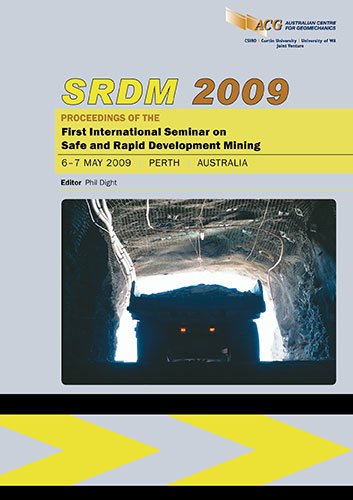The impact of an unexpected fault zone and groundwater in a ramp development on cost and production rate — a case study

|
Authors: Huang, Y Paper is not available for download Contact Us |
DOI https://doi.org/10.36487/ACG_repo/902_11
Cite As:
Huang, Y 2009, 'The impact of an unexpected fault zone and groundwater in a ramp development on cost and production rate — a case study', in PM Dight (ed.), SRDM 2009: Proceedings of the First International Seminar on Safe and Rapid Development Mining, Australian Centre for Geomechanics, Perth, pp. 121-127, https://doi.org/10.36487/ACG_repo/902_11
Abstract:
In mine development, cost per metre and production rate per shift are two of the most important criteria in terms of measuring economic results, work efficiency and technological advance. Therefore a key focus of engineering work in mine development is to reduce the cost and increase the production rate while meeting safety, environmental and production requirements. This paper presents a case study in which a ramp development encountered an unexpected fault zone. Because of the very fractured rock and high water conductivity in this zone, the cost per metre was sharply increased and the production rate per shift was dramatically reduced. This meant that a number of extra measures were required in order to efficiently advance through the fault zone. The water pressure encountered in many blastholes in the fault zone was more than 400 kPa and grouting was used in an attempt to control the water flow. In spite of this action the development drive back still collapsed, several further measures were required to rehabilitate the collapsed back and keep the development going. The nature of the fault zone, the grouting technology used, the rehabilitation measures for the collapsed drive back, the ground support policy adopted and the blasting techniques used in the fault zone are all discussed in this paper. The cost per metre and production rate per shift in going through the fault zone, compared with normal ground conditions, is estimated. This case study also provides a good example of the importance of obtaining detailed geotechnical data in advance, to facilitate correct location of mine development in good ground conditions.
References:
Daw, G.P. and Pollard, C.A. (1986) Grouting for ground water control in underground mining, International Journal of
Mine Water, Vol. 5(4), pp. 1–40.
Mikula, P.A. (1999) Choices in ground reinforcement at Mount Charlotte Mine, Proceedings of Rock Support and
Reinforcement Practice in Mining, E. Villaescusa, C.R. Windsor and A.G. Thompson (eds), Kalgoorlie, Western
Australia, 15–17 March, 1999, Taylor and Francis, London, pp. 285–294.
Schubert, C.J. and Stewart, C.M. (1999) Reinforcement design investigation at Big Bell, Proceedings of Rock Support
and Reinforcement Practice in Mining, E. Villaescusa, C.R. Windsor and A.G. Thompson (eds), Kalgoorlie,
Western Australia, 15–17 March, 1999, Taylor and Francis, London, pp. 301–316.
Rauert, N.S., Butcher, P.W., Ormsby, P.M. and Tully, K.P. (1999) The Development of ground support system at the
Pasminco Broken Hill Mine, Proceedings of Rock Support and Reinforcement Practice in Mining, E.
Villaescusa, C.R. Windsor and A.G. Thompson (eds), Kalgoorlie, Western Australia, 15–17 March, 1999, Taylor
and Francis, London, pp. 317–328.
The impact of an unexpected fault zone and groundwater in a ramp development on cost and Y. Huang
production rate — a case study
128 SRDM 2009, Perth, Australia
© Copyright 2024, Australian Centre for Geomechanics (ACG), The University of Western Australia. All rights reserved.
View copyright/legal information
Please direct any queries or error reports to repository-acg@uwa.edu.au
View copyright/legal information
Please direct any queries or error reports to repository-acg@uwa.edu.au